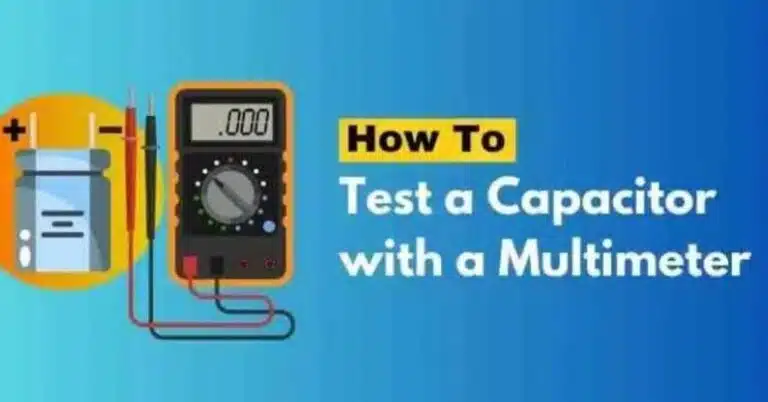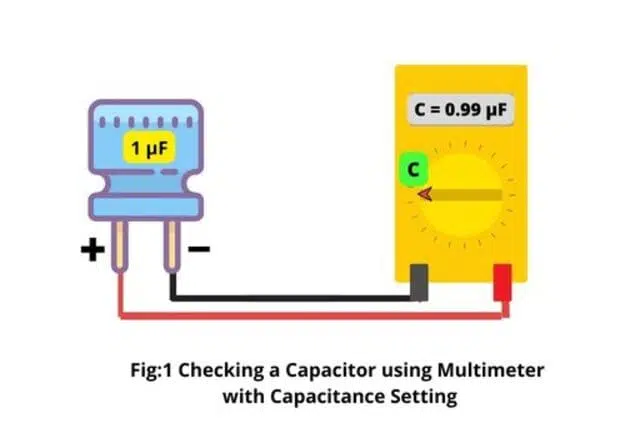

Are you trying to figure out how to test a capacitor with a multimeter in 2023?
As we know there are several ways to test a capacitor with the help of a multimeter. Follow this step-by-step guide to discover the tactics I used to diagnose the faulty capacitor.
A multimeter is a fantastic tool you may use to determine the capacitance by charging the known current. That measures the resulting voltage for capacitance calculation. Also, you can effortlessly get confirmation that the capacitor is damaged, faulty, or leaked.
With this in mind, we’ll explain how to check capacitor voltage with multimeter. Further, we’ll also guide how to check if a capacitor is bad without removing the component.
Use the multimeter and Connect the test leads to the capacitor terminals. Select the Capacitance setting on the multimeter and Read the measurement displayed. Please ensure that the capacitors from the circuit board are before starting testing. If the multimeter displays the capacitor’s value within the range it means that the capacitor is ok.
Here are a few different methods to test a capacitor. At the end of this article, we can get the answers to the below questions:
1. Using a Digital Multimeter With Capacitance Setting.
2. Using a Digital Multimeter Without Capacitance Setting.
3. Using an Analog Multimeter.
4. Testing a Capacitor With a Voltmeter.
5. Shorting the Capacitor Terminal.
This method is used to find the faulty capacitor by measuring the capacitance, Resistance, or potential difference across the capacitor. We will explain in detail how to measure capacitors to a Multimeter here.
If you want to learn how to test a capacitor with a multimeter, Follow this step-by-step guide to check and test for troubleshooting.
Warning: A capacitor may build up a dangerous residual charge. Before touching it or taking a measurement, Please ensure that you carefully discharge the capacitor by connecting a resistor across the leads. For Safe discharge, wear appropriate personal protective equipment recommended before any testing.
Here’s my favorite and familiar way of testing a capacitor with the help of a digital multimeter. It is also a straightforward and accessible method of capacitor verification.

Testing capacitors with a digital In modern digital multimeter, you can find a capacitance meter and a voltage meter. Similarly, this method works on tiny SMD components as well. The following instructions demonstrate using your digital Multimeter to test an AC capacitor.
It is this way that one can determine if a capacitor is bad. You can replace and troubleshoot your electronic device if the capacitor is faulty. It is a straightforward and standard method of testing a capacitor with a digital multimeter.
Several Digital Multimeters do not include a capacitance feature, so the above method is not applicable, but we can still test the capacitor by measuring its Resistance.

Step-by-step instructions on testing a capacitor with a multimeter by measuring its Resistance
By using other parameters, such as current (A), voltage (V), and Resistance (O), we can test the capacitor just like we can with digital multimeters. This section explains how to try the capacitor with a resistance measurement—this step-by-step guide on testing a capacitor with a simple analog multimeter.
To check whether a capacitor is defective, we will use a simple voltmeter to measure its voltage rating. You can follow these steps to test a capacitor with a voltmeter in the following section: Testing a Capacitor With a Voltmeter.
This method was more popular in the old days, as it did not require any measuring devices for validation. This article will discuss how to test a capacitor without a multimeter.
While this method is risky and not recommended by professionals, safety precautions should be taken if necessary. Protective gloves should be worn, and metal surfaces should not be touched. Following is a step-by-step guide on shorting the capacitor terminal to test a capacitor. The following steps are involved in testing a capacitor. Again, the question is the same: How to try the capacitor without desoldering the component and possible.
Another question is testing the capacitor without desoldering or removing the capacitor from the circuit board.